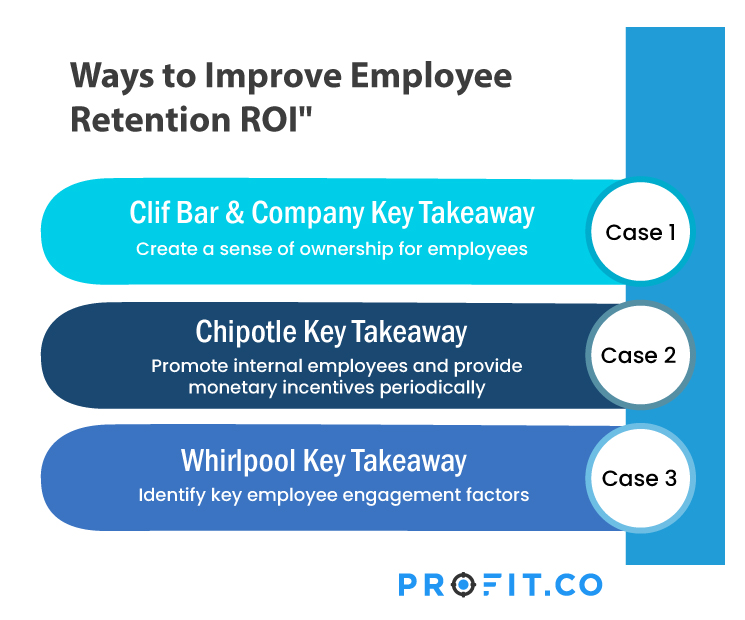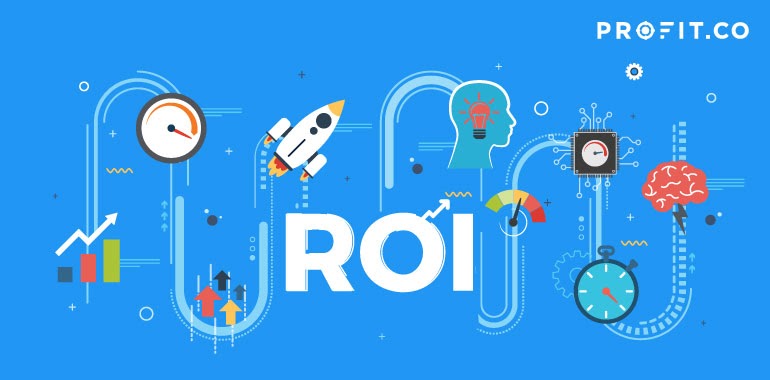Very few employees join a company for life any more. Given that 60% of Millennials have worked at 2-4 companies over their career to date, and 43% believe their company only cares about profits, it jbotust goes to show that employees, and particularly those under 40, value how they’re treated in a job over career longevity.
However, as we all know, recruitment, training, and onboarding are some of the highest staff expenses on a company’s books. This is why it’s vital for us to not only understand how many employees leave their jobs each year but why. Not only can this process improve employee engagement and happiness at work, but it can save thousands of dollars each year in replacing lost employees.
How to Calculate Employee Retention ROI
Understanding the cost of employee turnover can be a lengthy process, and there are so many factors that can’t necessarily be measured in monetary terms. However, for this article, we’re going to be covering employee retention ROI in terms of a dollar value only.
To get you started, here’s the standard formula for calculating return on investment:

And, to make things easier, we’re going to be using statistics from TLNT, which gives us the average cost of having to recruit a new employee and compensating for the loss of the previous employee at work.
- Entry Level: 30-50% of annual salary
- Mid Level: 150% of annual salary
- Senior/Professional/Highly Specialised Level: 400% of annual salary.
With these statistics in mind, let’s go through an example of how we can calculate employee retention ROI.
Example: Company A
Company A is a small tech startup with 50 employees. However, last year, they lost 10 employees, most of whom cited unreasonable deadlines and poor work-life balance as the reason why they left. Here’s the turnover breakdown:
- 2x Entry-Level Employees: Average salary $40,000
- 3x Mid Level Employees: Average salary $70,000
- 5x Senior Employees: Average salary $100,000
Let’s assume that this cost the company a flat 50% of each employee’s salary to recruit, onboard, and train their replacements. So, this loss of talent cost the company $395,000.
To avoid losing employees in the same volume, Company B invests $150,000 into improving employee life, which includes dedicated training hours during work, defining their company goals, and discounted childcare.
This year, they lose 4 employees:
- 2x Entry-Level Employees: Average salary $40,000
- 1x Mid Level Employees: Average salary $70,000
- 1x Senior Employees: Average salary $100,000
This means that this year, they only spend $125,000 on turnover, reducing their costs by $270,000. Now we have all the information we need to use the formula above.

This gives us a clearer picture of Company A’s employee retention efforts.
Why You Should Track Employee Retention ROI
The short answer is that every hour you spend training a new employee on how to do an old employee’s job is an hour the old employee could have been making the company money.
While we’ve used simplified figures above for the sake of demonstrating how to calculate employee retention ROI, it does demonstrate how expensive it is for companies to continuously have high employee turnover.
So many employees leave companies due to factors that could easily be controlled if the company was willing to invest time, energy, and money into improving employee life. Therefore, tracking employee retention ROI is one of the best ways to understand the true financial cost of unnecessary employee losses.
Also, tracking how many people leave your company each year is a good indication of employee engagement, morale, and productivity. If you’ve got a high turnover rate of employees each year, then this often tells us that many employees are unhappy and waiting to jump ship the moment a better opportunity arises.
Target Employee Retention ROI Figures
Every company will have a different understanding of how much employee turnover is too much. After all, retail and hospitality will have an easier time recruiting than specialized STEM industries.
However, as an employer, you’re always going to be aiming to maintain a low turnover rate while keeping a high employee retention ROI.
One key thing to watch is the estimated turnover rate of your competitors and your industry as a whole. This is a good indicator as to how your company is performing, and by examining your competitors, you can understand how to improve your employee retention ROI.
Improving Employee Retention ROI

One of the most important things you can do in response to a poor employee retention ROI is to understand why your employees are leaving their jobs.
Some common reasons why people leave include a lack of empathy in their bosses (92%), bosses not caring about their happiness (79%), they don’t feel valued (72%), and a lack of up-to-date technology (70%).
From these statistics, it’s clear that a high employee turnover rate can be an indication of poor management, and so tracking employee retention ROI can be a powerful motivator for HR to change and coach bad managers.
Case Study 1: Clif Bar and Company, California
With a 97% employee retention rate, Clif is notable for its extraordinarily low rate of voluntary resignation.
One of the key reasons behind this is that Clif’s executives understand the value of creating a sense of ownership within the business. Not only do employees get the chance to purchase stock, but the company also invests heavily in employee training and development to help their people thrive.
They also expect managers at all levels to be directly involved with employee perks. Many companies are cluttered with unwritten rules about how employees should get involved, so they wanted to make sure that there were no barriers to people participating in company activities. One of the biggest incentives is that Clif pays its employees to exercise in their on-campus gym for two hours a week, and the CEO directly monitors how many employees engage with this program to make sure that it’s being used.
What does this teach us?
This case study shows us that employees need to feel valued at work, and they also need to feel part of a company that cares as much about their professional development as they do. Also, ensuring that management gets involved with employee benefit programs means that people don’t feel restricted by unwritten rules and societal expectations. This also ensures that their management staff is well taken care of, making them less susceptible to stress which can directly harm their employee’s working environment.
Case Study 2: Chipotle
Chipotle was able to reduce its turnover rate by an astounding 64% by promoting their employees internally. When they implemented an internal promotion scheme, salaried managers were twice as likely to stay with the company, and hourly managers three times as likely.
Also, Chipotle offers all of its management a one-off staff development bonus of $10,000 if they bring up one of their staff members into a managerial position, incentivizing current managers to train their employees and promote from within. In 2010, the company paid out $1 million in these bonuses.
What does this teach us?
Not only can promoting from within reduce employee retention ROI, but it can be a key factor in employee performance improvement. So, this can be a powerful tool to both reduce employee turnover costs and improve employee engagement. The staff development bonuses for managers are paid in two halves, with the first half released when an employee is promoted to a managerial position, and the second half after 6 months of great performance from the new manager. This incentivizes current managers to not only invest their time into helping their staff grow but also to do so in a way that helps them progress throughout their career.
Case Study 3: Whirlpool
In 2015, Whirlpool noticed that despite having made great strides in attracting and hiring employees from a diverse range of backgrounds, they were losing those employees at a faster rate than they could hire them. In response, Whirlpool’s HR departments compiled a retention risk assessment toolkit, which looked at the impact of an employee leaving, what drove employees to leave, and how they could prevent losing talent.
The risk assessment itself included 25 yes/no questions that managers had to answer about their employees, and those answers were calculated to understand the risk of an employee leaving. During the trial period, the key finding was that management tended to rate their relationship with their employees as stronger than their employees did, and employees highlighted key engagement factors that were regularly missed by managers.
Once the risk assessment toolkit was piloted, Whirlpool found that the loss of female employees dropped from 21% to 9%, and employees lost from underrepresented minorities fell from 28% to 14%.
What Does This Teach Us?
One of the most important factors in employee performance improvement and a high employee retention ROI is how they interact with their managers. When poor management practices were directly addressed by this risk assessment program, employee attrition amongst minority groups was significantly reduced. However, managers themselves are not a reliable judge of their relationships with their employees, and retention programs must always involve employees to understand how working relationships function.
Improving Employee Retention with Profit.co’s Performance Management Module
When a company is attentive to the needs and potential of their employees, retention can increase. In the Profit.co software, we have two features that can help with recognizing employees and addressing their needs.
Individual Development Plans (IDPs):
When you have an exceptional employee who not only thrives in their position but shows the potential needed for a promotion to a new role, HR Administrators can initiate an IDP. This puts these promising employees on a track toward their promotion. With an IDP:
- Employees are assigned a mentor to guide them through their development, and to teach them about their anticipated role.
- HR can set a target date for when this promotion might take place
- Details concerning what this employee can do to prepare for this role can be added to the IDP form, and the process can be initiated.
Internally promoting with an IDP lets current employees know that there is upward mobility within a company, and that they are being recognized and rewarded for their hard work.
Performance Improvement Plans (PIPs):
Many employees cite difficulty with their position and a lack of support as their reason for leaving a company. If there are struggling employees within your company, you can initiate a PIP to get them back on track.
- Employees are assigned a coach to help retrain them on skills required to perform acceptably in their position.
- Target areas for improvement are identified and can be referred back to by the employee, managers, and HR professionals.
- Examples for times when the standards were not met are recorded for the benefit of the employee to reflect on and HR to harken back to.
- Expected outcomes are added to the plan so that everyone is on the same page about where the employee needs to be in order to be successful in their position.
With these features in Profit.co that address employee development and improvement, employees can feel recognized, rewarded, and supported– subsequently improving employee retention at your company.
